How Rainfall Films Made Los Angeles Burn with Cinema4D
Britney Spears’ name didn’t come up at first. All Sam Balcomb and Jeff Dodson of Rainfall Films knew was that they needed to create 25 VFX shots in which Los Angeles would crumble and burn as if it were the apocalypse. And they needed to do it in five days. “We couldn’t believe the timeline,” recalls Balcomb, who co-produced the shots with Dodson. “But we’ve worked with the director Ray Kay (Rockhard Films) before, and he always brings us fun projects. So we said yes.”
C4D + RayFire
The first challenge was finding a way to make buildings in plate shots of downtown L.A. blow up or disintegrate as if a big earthquake was rocking buildings and bits were raining down. Dodson and Balcomb opted to use the RayFire plugin, which is specifically designed to detonate, burst and break things, for the job.
RayFire calculated the physics needed to create scenes of buildings crumbling and falling in downtown LA. (Click animated image, above, to see full-size image sequence.)
Starting with a still plate of downtown buildings against a clear, blue sky, they created a digital matte that included clouds and dark colors, as well as rough geometry of the nearest building. RayFire calculated the destruction physics, which were then brought back into C4D. “It’s imported into C4D through OBJ sequence, so you get a nice animation that fits into the geometry you constructed,” Balcomb explains. “Then you can do your texturing, lighting and rendering.”
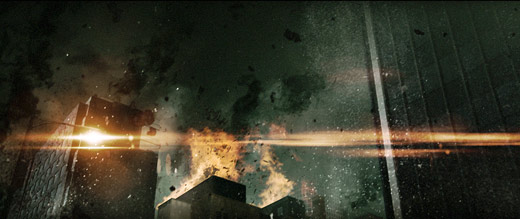
Tracking information, the digital matte and the C4D render were brought together in After Effects for final compositing.
They also shot some live-action footage with a Canon 7D. “To get action shakes we took tracking marks and put them on a wall,” explains Dodson. To get a natural, hand-held look they shook the camera with different intensities, captured it and tracked it with SynthEyes into virtual camera information. That tracking information, the C4D render, and the digital matte were all brought together in After Effects, where final compositing, rotoscoping and additional effects, such as lens flares, were done.
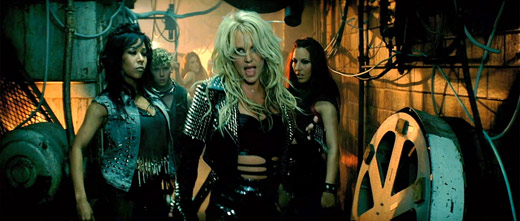
Ray Kay, who directed the video, also worked with Rainfall on Willow Smith’s “Whip My Hair.”
The combination of C4D, RayFire and After Effects was a success. And Kay, who also worked with Rainfall Films on Willow Smith’s “Whip My Hair” music video, loved Dodson and Balcomb’s test shot. That meant they were free to get moving on their deadline. “The funny thing was our prep time was longer than the rest of the time we had to work on the project, so we were concerned about being able to do the same thing on every shot,” says Dodson, adding that Kay kept citing director Roland Emmerich’s 2012 as a reference. “I’m pretty sure more than two people worked on that for more than three or four days,” Balcomb adds, laughing.

Rainfall Films started with a rough object in C4D when making the giant asteroid that menaces LA in Spears’ video.
Making the Apocalypse Look Real
Balcomb and Dodson say that what they like most about music videos is that every one of them is different. “That’s what keeps things interesting,” Balcomb says. In this case, the primary unique element was a big, hulking asteroid hurtling toward Earth. They started with a rough object in C4D and animated it before bringing it into RayFire and breaking up one end a little bit, allowing debris to fall off as it moved through space. Texturing and lighting were also done in C4D.

Stars were made using a dense particle sequence that was composited into the shot.
“We used C4D’s sub-poly displacement with a customized noise field to add lots of sub-polygon detail to the surface of the asteroid,” Dodson explains. For the stars in the background, they created a dense particle sequence and composited it into the shot.
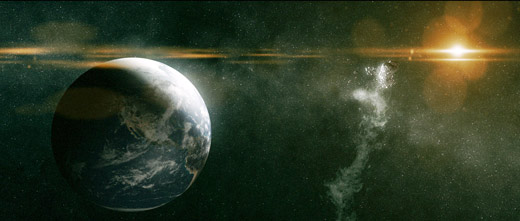
Rainfall used a combination of C4D, RayFire and After Effects to produce VFX on a tight deadline.
Balcomb and Dodson had a few stock shots they wanted to use to make it look as if clouds were actually opening up to allow the asteroid to pass. But the resolution of the footage was too low. “Instead,” recalls Balcomb: “We layered a lot of still frame clouds and used fractal warp to make them move around slowly, simulating realistic cloud movement and making sure they didn’t move too fast so they wouldn’t look fake. I’ve seen the technique used on matte paintings but I’d never tried it before, so we messed around with displacement until we came up with something that worked for us.”
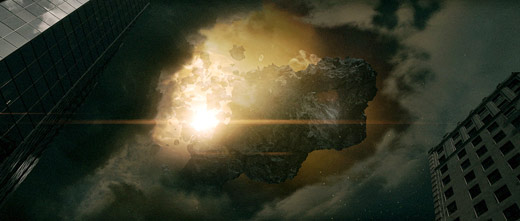
It took some work to get the right look for the clouds, which part as the asteroid passes through them.
Once they got their process for both the asteroid and city destruction scenes down, the deadline seemed more doable because every shot had a similar workflow with different geometry, Dodson says. Like most projects, this one had a last-minute request: that little card flashing the ominous date of December 21, 2012, across the screen briefly. (See Emmerich’s disaster flick for more details on what could happen on this date.) “This was about an hour before the video was going online, so we were able to throw a camera in there and render a quick three-second shot with the asteroid and go,” says Balcomb.
Camera-mapped footage and 3D pipework make it look as if Spears and her dancing friends actually traversed a bit of sewer to get to and from the party. (Click animated image, above, to see full-size image sequence.)
There was a magic camera move in the video, too. Believe it or not, Britney did not actually slink down into the sewer through a manhole to host her dance party, nor did she pop back out to check on the state of the world. “We used C4D for the shot where the camera lifts up through the ground,” Dodson explains. “For that we had to camera-map footage of the ground starting down in the sewer and crane up to the street above. The two shots were married, and then we created some 3D pipework in the ground and camera-mapped the top one onto a fake floor so we could get some depth to it.”
Meleah Maynard is a Minneapolis-based writer and editor. Contact her at her website: www.slowdog.com.
Did you enjoy this article? Sign up to receive the StudioDaily Fix eletter containing the latest stories, including news, videos, interviews, reviews and more.
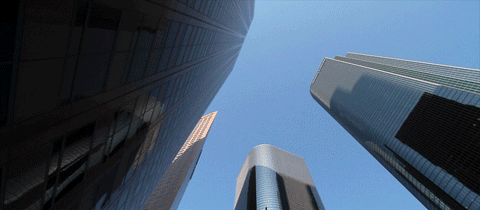
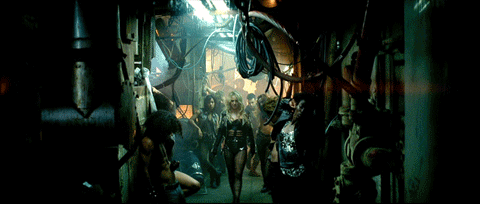










Leave a Reply